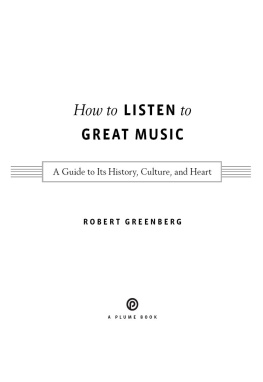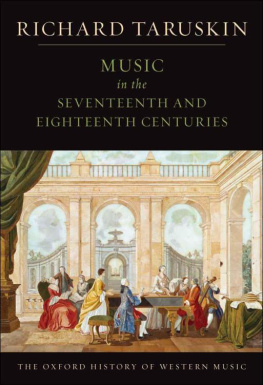MUSIC in the
BAROQUE ERA
FROM Monteverdi TO Bach
By
MANFRED F. BUKOFZER
PROFESSOR OF MUSIC, THE UNIVERSITY OF CALIFORNIA


BY
W. W. NORTON & COMPANY, INC.
NEW YORK, N. Y.
PRNITED IN THE UNITED STATES OF AMERICA
FOR THE PUBLISHERS BY THE VAIL-BALLOU PRESS
IN MEMORY OF
ANDR PIRRO
(18691943)
A Pioneer of Baroque Music
CONTENTS
English Master Period: OperasOratoriosInstrumental
Music
ILLUSTRATIONS
Entrance of American Music
Aeolian Mode |
The Division Violist
Lucretia |
Henry Purcell
Franois Couperin |
Johann Sebastian Bach
George Frederick Handel |
PREFACE
THE FIRST book in the English language on the history of baroque music does not need either apology or justification. Histories of music have been written usually as quick surveys of the entire field and if they specialize at all they concentrate as a rule on a single composer. It is a strange though incontestable fact that by far the great majority of music books deal with composers rather than their music. This attitude is a survival of the hero-worship that characterizes the nineteenth-century approach to music as well as the other arts. In a history of a single musical period the shortcomings of such an approach become particularly obvious. A musical era receives its inner unity from the musical style and can be historically understood only in terms of stylistic development. It is for this reason that in the present history of baroque music the stylistic approach has consistently been adopted. Biographical information, easily accessible in musical dictionaries, has been reduced to a minimum in order to leave space for the discussion of stylistic trends and characteristics of style, usually ignored in the dictionaries.
I have written this book for the music student and music lover with the aim of acquainting him with a great period of musical history and helping him to gain a historical understanding of music without which baroque music cannot fully be appreciated and enjoyed. If the history of music is to have more than an antiquarian interest and significance, it must be seen as a history of musical styles, and the history of styles in turn as a history of ideas. The ideas that underlie musical styles can only be shown in a factual stylistic analysis that takes music apart as a mechanic does a motor and that shows how musical elements are combined, how they achieve their specific effect, and what constitutes the difference between externally similar factors. This analysis is at once historical and technological and takes beauty for granted. Those writers to whom the description of music is no more than a matter of elegant variation in judiciously chosen adjectives may be shocked to learn that the word beautiful does not occur in this book. My aim has been not the expatiation on the obvious but the explanation of the specific musical results of baroque style. This explanation must of necessity rely on words, but it must be clearly understood that words cannot render the aesthetic experience of music itself, let alone replace it. Familiarity with the rudiments of music is assumed in this book though it is not designed for specialists nor has it been written, for that matter, by a specialist of the period. But even the specialized musicologist will find a few new facts, new interpretations, and a number of hitherto unpublished examples. In the organization of material I have departed from the usual practice by not making the book a strictly chronological report. The main principle of organization is style in its various manifestations. Chapters II-IX comprise the actual history of baroque style. The first and the three last chapters cut across the field and complement the subject: the first gives a general comparison between renaissance and baroque style, the three last deal with aspects of form, theory, and sociology, rarely, if ever, discussed in histories of music. Several chapters were first presented publicly in a lecture series at the University of Chicago in 1945, and for the Northern California Chapter of the American Musicological Society in 1946.
For reasons of space the bibliographical footnotes have been restricted essentially to references to musical reprints. Through the courtesy of Dr. Willi Apel I was able to incorporate references to the second volume, as yet unpublished, of the Historical Anthology of Music which contains many valuable examples of baroque music. It goes without saying that the material presented in this book is based largely on the special studies listed in the bibliography. Unfortunately for the music student the majority of these books and articles is written in languages other than English. Such excellent stylistic studies as those by J. A. Westrup (Purcell) and Ernst Meyer (English Chamber Music) are all too rare exceptions. The bibliography stresses style-criticism and includes only those biographies that consider the musical style of the composer. Although it is the largest bibliography of baroque music ever printed it is far from being complete. The inclusion of local and archives studies would have doubled its size. The checklist of baroque books on music represents a new bibliographical venture the aim of which has not been completeness, but comprehensive coverage of the various aspects of musical literature in a given period, the detailed study of which raises fascinating problems. Prolific writers like Mattheson and others appear in the list only with their most important titles. Items that appear in a footnote in incomplete form are more fully cited in the bibliography. It should be noted that throughout the book major and minor keys are differentiated by means of small and capital letters; for example, c and C stand for C-minor and C-major, respectively.
It is my pleasant duty to acknowledge the help and advice I received from many friends and colleagues. I am especially grateful to Dr. Alfred Einstein of Smith College who took a fatherly interest in my book and permitted me to use some examples from his rich treasure of early baroque music, and to Professor Edward Lawton of the University of California who put his scores of the works of Gesualdo and several photostats at my disposal. I gratefully recall the assistance of the following institutions: the Music Division of the Library of Congress, New York Public Library, Newberry Library, British Museum, Metropolitan Museum of Art, Union Theological Seminary, and the library of the University of California. Last but not least my thanks go to my wife. Without her unflagging encouragement and help this book would not have been possible.
Manfred F. Bukofzer
Berkeley, California
CHAPTER ONE
Renaissance Versus Baroque Music
DISINTEGRATION OF STYLISTIC UNITY
WHEN Monteverdi in his fifth book of madrigals (1605) asserted that he did not follow the precepts of the old school, but was guided by what he called the seconda prattica, he spoke with the self-assertion of an artist fully conscious of a fundamental change in the conception of music. Monteverdi was retorting in his statement to an abusive attack of Artusi, in which this conservative critic and theorist found fault with Monteverdis treatment of dissonance. By opposing the second practice to the first, and by implying that the standards of the old school could not be applied to the new, Monteverdi challenged the whole basis of the argument. Thus the eternal controversy between artist and critic about the standards of art criticism flamed up in the violent manner that is indicative of all periods of transition.













